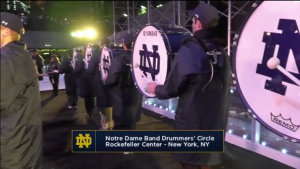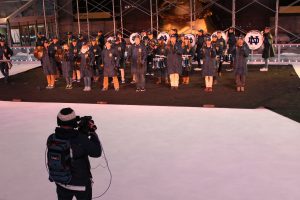LiveU Bonded Cellular Streamlines Notre Dame’s Night in NYC
The live-streamed production showcased the holiday season in the Big Apple
Story Highlights
Weeks before the University of Notre Dame clinched a berth in the College Football Playoff, the Fighting Irish squared off against Syracuse in the 2018 Shamrock Series at Yankee Stadium. Fans in the area were in for a treat, with the Notre Dame marching band playing a pair of concerts in two iconic locations in New York City: Bryant Park and Rockefeller Center. LiveU’s bonded-cellular infrastructure allowed the content to be sent more than 800 miles away to South Bend, IN, for a live-streamed production.
“The purpose for the fans that were watching was to bring them Notre Dame in New York City,” says Mike Bonner, executive producer, live events, University of Notre Dame. “If you couldn’t make it to New York City, we wanted to bring it to your device, your computer, or wherever you were watching. It was a great success.”
At-Home Production
While Bonner was on the ice during the 45-minute event at Rockefeller Center, a producer and an engineer managed the production in the comfort of ND Studios on campus. To ensure viewability and accessibility, the event was live-streamed on numerous outlets, including social media (Facebook Live), the athletics website (UND.com), and the university’s on-the-go-platform (ND Mobile app).
While the event took place in Manhattan, the production staff simultaneously edited the footage for further use during the game and the weeks that followed.
“One of the jobs was taking [the content] into our [Evertz] DreamCatcher, clipping off shots, and exporting them into a shared folder,” Bonner says. “The beauty of LiveU is that everything is happening in real time. I didn’t have to record [the event] on a card and bring it to a computer to ingest the footage.”
One of the promotional videos (shown below) took advantage of the system and had the video ready for the next day’s game.
Managing Connectivity and a Crowded Area
New York City during the holiday season can bring thousands of crowds, especially to famous landmarks. At Bryant Park, Bonner used an Ethernet cord to tap into a perfect uplink. For the nightcap at Rockefeller Center, he took extra precautions to prevent latency and signal issues.
“I didn’t have [Ethernet] availability at Rock Center, so it was definitely an ‘Okay, how is this going to be,’” says Bonner. “The signal was perfect without a single dropout. We had quite the crowd there, so I was super impressed with how well it took the bonded cellular.”
In addition, the LiveU equipment allowed him to travel with as small a footprint as possible. “I was able to walk from both events,” he says. “I had the backpack on my shoulder, the tripod in my right hand, and a camera bag in my left hand. That was it.” After the doubleheader of performances, the social-media numbers provide context on how well-received the events were.
On Facebook, the band at Bryant Park and the drummers’ circle at Rockefeller Center accounted for the top-two most-watched videos in November. The drummers’ circle logged 175,570 individuals, 89,000 views, 33,585 shares, and 1,019 shares. The concert earlier in the day caught the attention of 118,500 people, captured 60,645, and was shared 542 times.
The Effect of Bonded Cellular and the Future of ND Studios
After a smooth production and positive feedback from the community, bonded cellular from LiveU is set to play a crucial part in plans for the program. In the short term, Bonner and the team can use this technology to showcase the festivities of the college football postseason. In the long term, the possibilities are endless.
“There are things in the past where we would say, ‘Wow, that would be great to live-stream, but I don’t know if we can do it,’” he says. “[Bonded cellular from LiveU] allows us to try new things. Having the flexibility and the ability to go live anywhere is incredible.”


